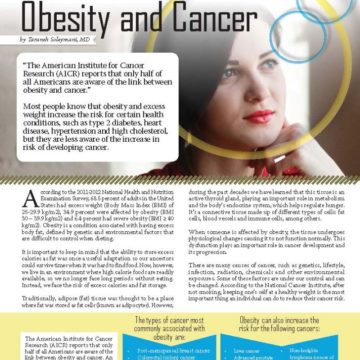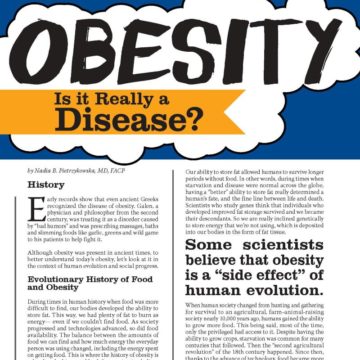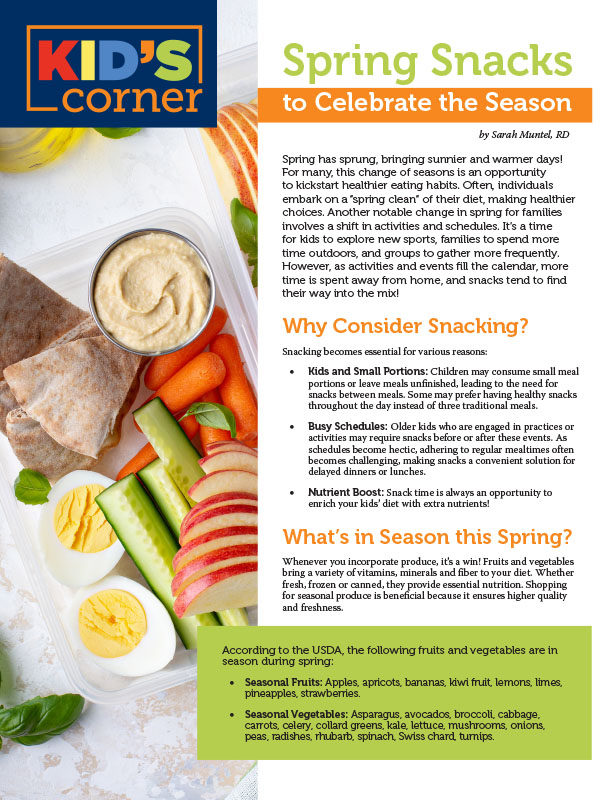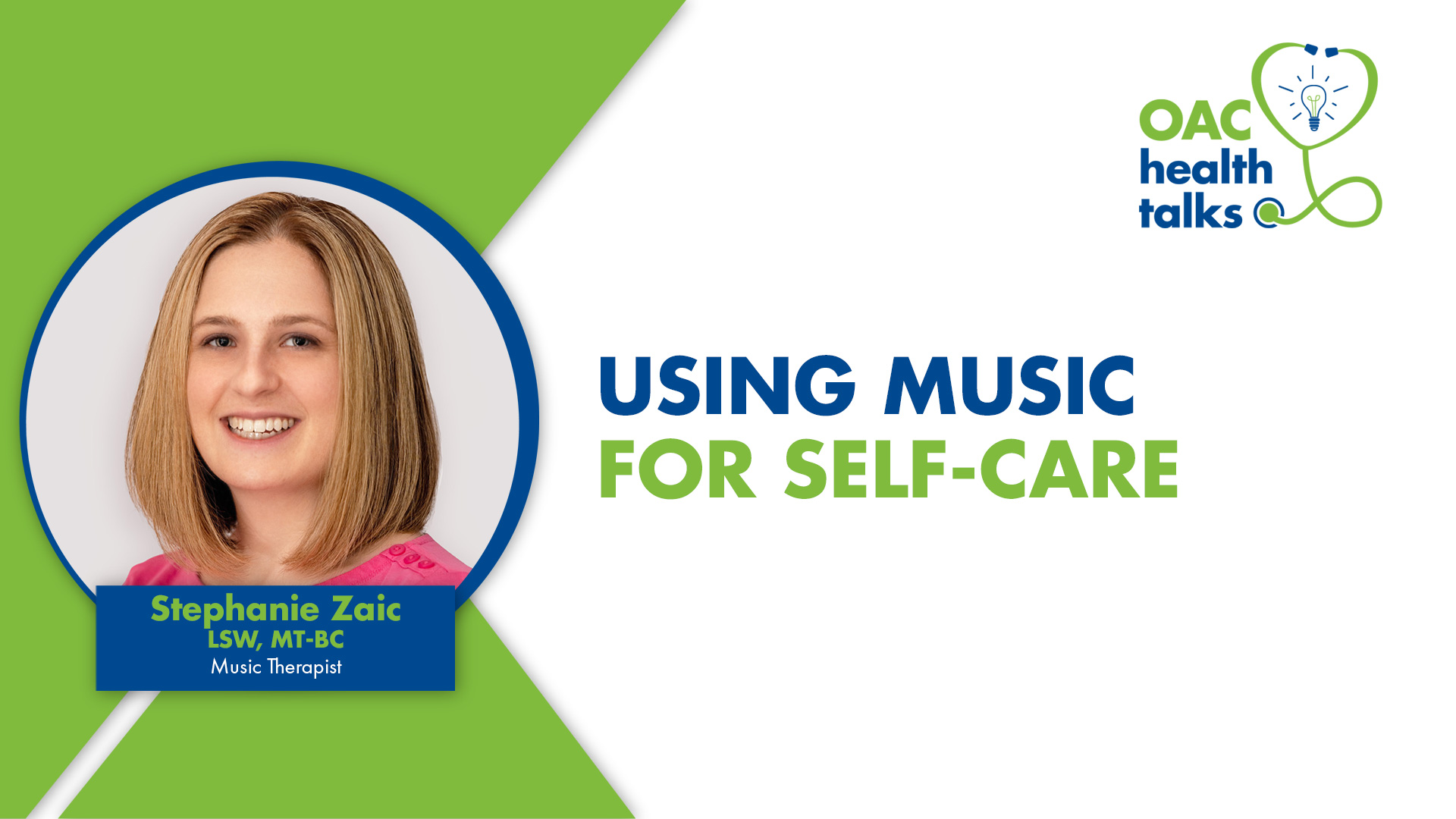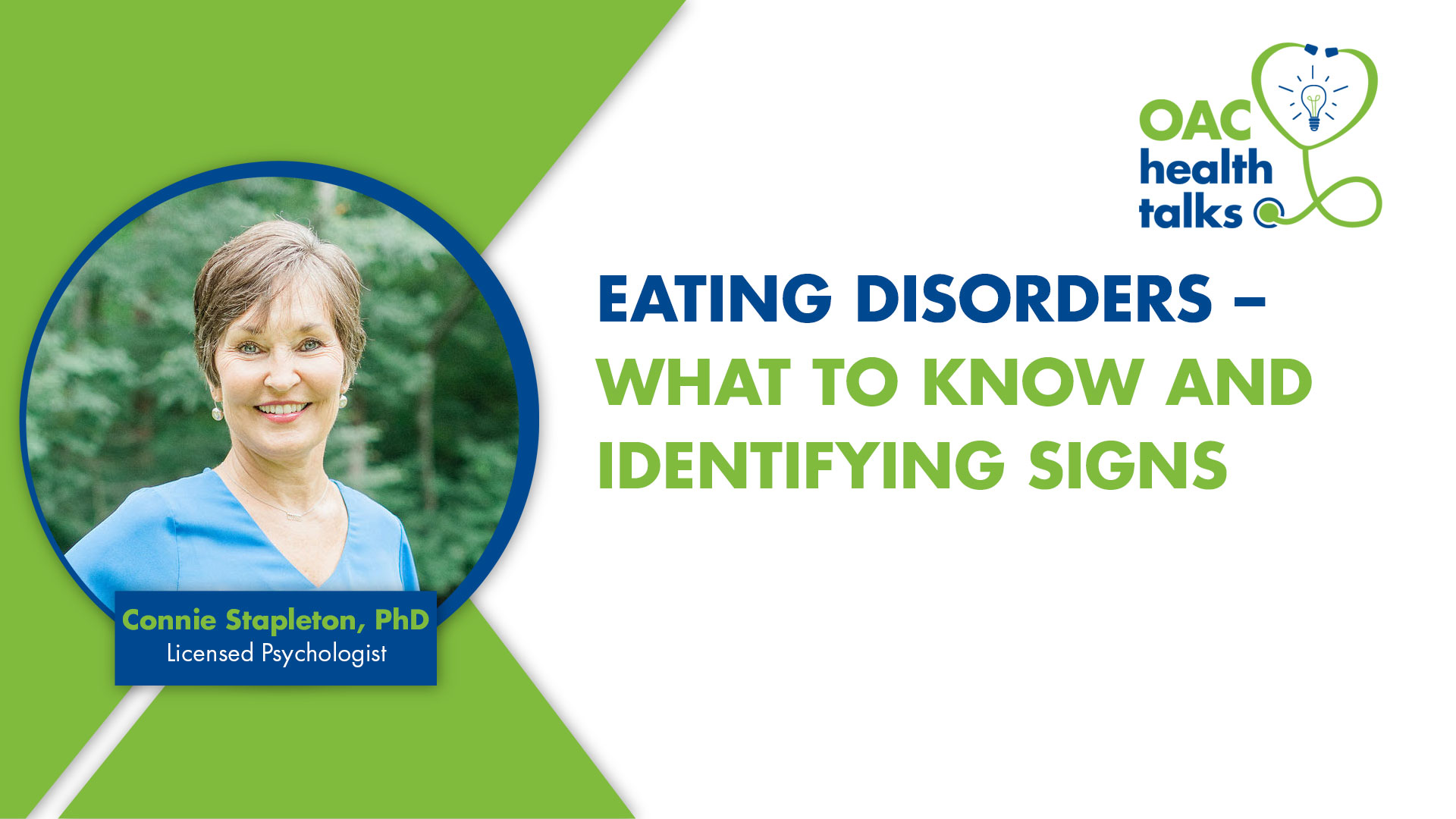What is Mindful Eating?

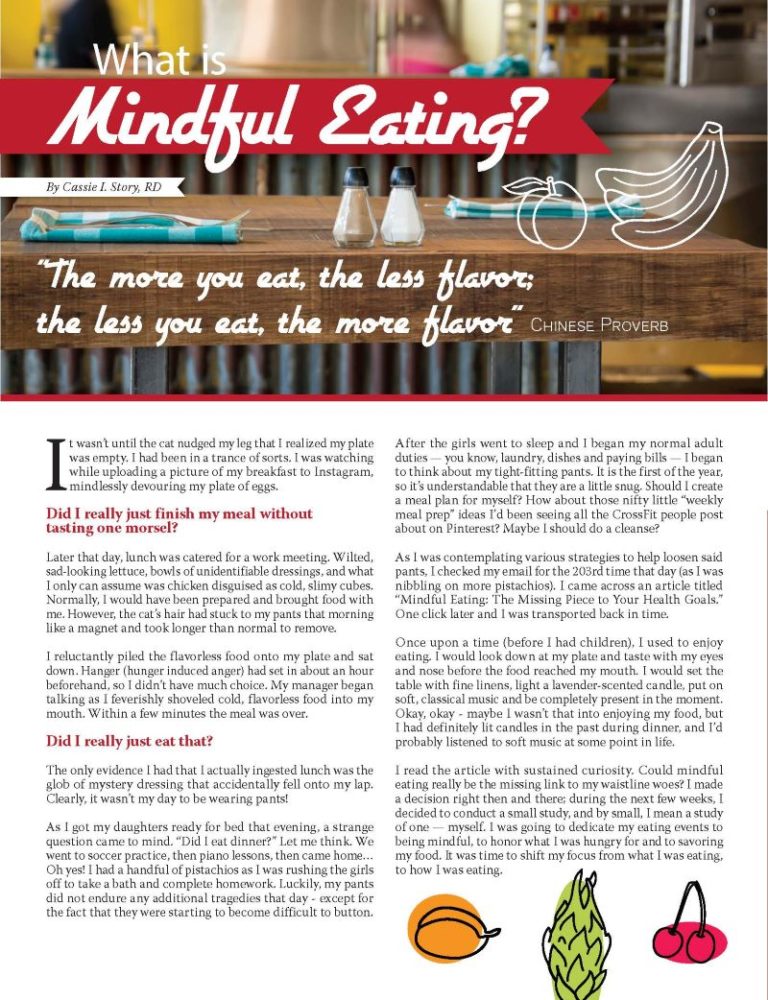
by Cassie I. Story, RD
Winter 2016
It wasn’t until the cat nudged my leg that I realized my plate was empty. I had been in a trance of sorts. I was watching TV while uploading a picture of my breakfast to Instagram, mindlessly devouring my plate of eggs.
Did I really just finish my meal without tasting one morsel?
Later that day, lunch was catered for a work meeting. Wilted, sad-looking lettuce, bowls of unidentifiable dressings, and what I only can assume was chicken disguised as cold, slimy cubes. Normally, I would have been prepared and brought food with me. However, the cat’s hair had stuck to my pants that morning like a magnet and took longer than normal to remove. I reluctantly piled the flavorless food onto my plate and sat down. Hanger (hunger induced anger) had set in about an hour beforehand, so I didn’t have much choice. My manager began talking as I feverishly shoveled cold, flavorless food into my mouth. Within a few minutes the meal was over.
Did I really just eat that?
The only evidence I had that I actually ingested lunch was the glob of mystery dressing that accidentally fell onto my lap. Clearly, it wasn’t my day to be wearing pants! As I got my daughters ready for bed that evening, a strange question came to mind. “Did I eat dinner?” Let me think. We went to soccer practice, then piano lessons, then came home… Oh yes! I had a handful of pistachios as I was rushing the girls off to take a bath and complete homework. Luckily, my pants did not endure any additional tragedies that day – except for the fact that they were starting to become difficult to button.
After the girls went to sleep and I began my normal adult duties — you know, laundry, dishes and paying bills — I began to think about my tight-fitting pants. It is the first of the year, so it’s understandable that they are a little snug. Should I create a meal plan for myself? How about those nifty little “weekly meal prep” ideas I’d been seeing all the CrossFit people post about on Pinterest? Maybe I should do a cleanse?
As I was contemplating various strategies to help loosen said pants, I checked my email for the 203rd time that day (as I was nibbling on more pistachios). I came across an article titled “Mindful Eating: The Missing Piece to Your Health Goals.” One click later and I was transported back in time.
Once upon a time (before I had children), I used to enjoy eating. I would look down at my plate and taste with my eyes and nose before the food reached my mouth. I would set the table with fine linens, light a lavender-scented candle, put on soft, classical music and be completely present in the moment. Okay, okay – maybe I wasn’t that into enjoying my food, but I had definitely lit candles in the past during dinner, and I’d probably listened to soft music at some point in life.
I read the article with sustained curiosity. Could mindful eating really be the missing link to my waistline woes? I made a decision right then and there; during the next few weeks, I decided to conduct a small study, and by small, I mean a study of one — myself. I was going to dedicate my eating events to being mindful, to honor what I was hungry for and to savoring my food. It was time to shift my focus from what I was eating, to how I was eating.
What is Mindful Eating?
Principals of mindfulness:
-
- Deliberately paying attention to the present moment
- Being aware of your thoughts, feelings and physical sensations without judgment
- Paying attention to internal and external cues in the moment they are occurring
Mindful eating is:
-
- Eating food in a way that promotes respect to your body
- Being in the moment while eating, and acknowledging your personal likes and dislikes
- Becoming aware of physical hunger and satiety (fullness) cues to guide your eating choices
- Without judgment, selecting food that is satisfying to you and nourishing to your body
A person who eats mindfully:
- Savors each eating experience
- Is aware of how certain foods feel in their body and makes food choices that support their health and well-being
- Practices mindfulness to promote balance and acceptance of themselves as they are today
While I was preparing for my small study of one, I consulted my favorite scientific source, Google. Where was I going to start? Based on the various articles that I read regarding “mindful eating,” I kept seeing a few common strategies listed:
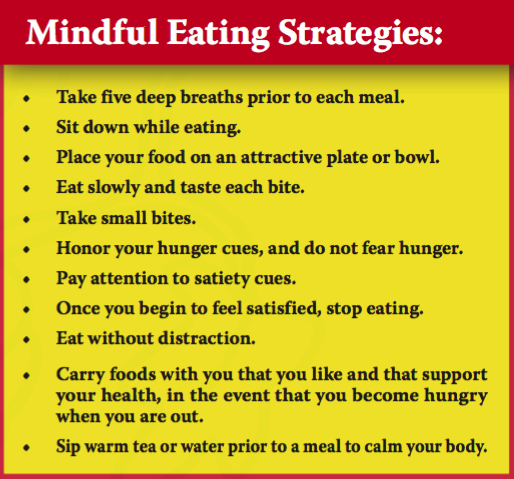
Preparing for Mindful Eating
Before I started my new mindful eating adventure, I needed to go shopping. Not for new pants, but for food. If mindful eating was going to work, I needed to have my food environment stocked with foods that I enjoyed. I purposefully came to the store without a list. I wanted to focus on purchasing what looked good, instead of focusing on what I “could” or “couldn’t” have.
First stop, the produce section. The blueberries were mushy. The carrots lacked color. I was sick of apples. Then suddenly, I looked to my left and spotted this gorgeous emerald broccoli, glistening under florescent lights from the shower it just received. Yum. To the right, I noticed ruby red strawberries; I picked them up and used the smell test. Divine. Those would be delicious for breakfast.
As I continued to push my increasingly full cart around the store, I felt empowered. The foods I was choosing were not based on some latest diet craze. They were foods that I liked and made my body feel good. Then I came to the grain aisle and had to pause. I was faced with my first real dilemma. For years I’d been buying brown rice. Recently, I started to purchase quinoa, but you know what? I don’t really like quinoa. I know the deal, it’s a ‘superfood’ packed full of fiber, protein and B vitamins, but I just don’t like it.
If I was going to honor the rules of mindful eating, which included eating things that I liked, what should I do in this situation? Then something caught my eye, something that hadn’t touched my shopping cart in over a decade — white rice. I remember white rice: sticky, slightly sweet and perfect with beef and broccoli. Could I, in good dietitian conscience, buy this? I surveyed my cart. It was filled primarily with whole foods that I love. I guess adding white rice to it wouldn’t be the end of the world.
Putting it into Practice
That evening for dinner, I dimmed the lights in the kitchen, and turned off the TV. I sat down at the table and took five deep cleansing breaths. Then I looked down at my plate. Spicy stir fried beef with perfectly steamed broccoli sat on top of a small pile of mouthwateringly sticky white rice. I took a few moments staring at my plate. No judgment, simply admiring this beautiful meal that I created. The first bite was divine. Soft and fluffy, I’d forgotten how much I loved white rice. I savored each and every bite.
My daughters looked at me like I’d gone crazy. Why was their mother making audible pleasure noises while eating? I didn’t care. I was reconnecting with something that had long been missing, eating not only for nourishment but also enjoyment. As I continued this tuned-in practice, I noticed after about 10 minutes that I was no longer hungry, and starting to feel a bit full. Not “Thanksgiving let me change in to my sweatpants full,” but full-ish. I decided to stop eating and talk to the girls about various things that were going on in their lives. Which boy did my eight year old like this week? And was my six year old excited about her upcoming field trip to the science museum?
After a few minutes of talking, I looked back down at my plate. There was still some food on it, but it didn’t look as appealing as it had 15 minutes ago. Another mindful eating rule popped in my head: Stop eating when you are satisfied. Lately, I stopped eating when my plate was empty. I was at a mental crossroads. Do I keep eating or let the meal be over?
I stood up and took my plate to the kitchen, and came back to the table with my daughters while they finished their dinner. It was at that time that I noticed something — my daughters seemed to naturally eat mindfully. They ate when they were hungry. They stopped eating when they were satisfied, and despite all my parenting efforts, they never ate quinoa. They were painstakingly slow eaters, and when they ate, they weren’t focused on all of the tasks they still had to complete that day, or what their friend was posting about on Facebook, or if their boss had emailed them. They just ate.
Conclusion
Throughout the next several weeks, I continued to focus on one mindful eating strategy at a time. I was not perfect, but that’s okay. I found that some ideas worked very well for me, like taking a few deep breaths before eating, and sitting down to eat. While others weren’t my favorite, like eating without distraction and placing my food on a pretty plate (not sure that placing a protein bar on a plate would really work for anyone). I was slowly beginning to change my eating habits. I found that being present in the moment with eating allowed me to eat less, and enjoy my food more. And you know what else happened? My pants avoided further food-related causalities — the cat, however, just got shaved.
“Part of the secret of success in life is to eat what you like and let the food fight it out inside.” – Mark Twain
About the Author:
Cassie I. Story, RD, is a dietitian who has been working with bariatric patients for the past 11 years. She also has her own food blog, www.WLSDailyPlate.com, to help inspire healthy eating following bariatric surgery. She enjoys cooking, hiking and spending time with her two daughters in Arizona.
Additional Resources about Mindful Eating:
“Intuitive Eating” by Evelyn Tribole and Elyse Resch – A guide to healthy eating based on your personal food needs and your psychological relationship with food.
“Am I Hungry?” by Michelle May, MD – Helping people break the never ending diet cycle. Visit amihungry.com for free resources.
“Eat, Drink, and be Mindful: How to End Your Struggle with Mindless Eating and Start Savoring Food with Intention and Joy” by Susan Albers, PsyD – A collection of more than 70 worksheets that the author uses with her clients to increase mindful eating.
by Sarah Muntel, RD Spring 2024 Spring has sprung, bringing sunnier and warmer days! For many, this…
Read ArticleDid you know that stress can have an impact on weight? Many people increase their food intake…
View VideoEating disorders can be a concern or question for many who are along the journey to improved…
View Video




